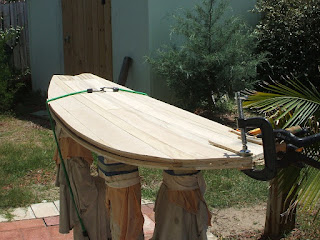My last post was about an issue I was having with laminating the fins. This time it worked out and I was able to get a good bond between the wood and the glass. I laid up 3 full layers of S2 glass and 2 half layers.
Today my plan is to do the filler and hot coat on the top. It takes some prep work to set it up. I sand any high spots and try to blend as much as possible.
I tape off the bottom edge with green tape.
I make a little breather tube so the board can breathe.
For my fill coat I need a brush, spreader, calibrated cup, respirator, resin and gloves.
When I do my filler and hot coats I use a method similar to the one in this link.
Filler coat and hot coat
As soon as I'm satisfied with the coating. I take it out and cure it.
This is where I differ from the video. I sand the board again with 100 grit and remove any high spots.
I rinse the board and tape off the bottom again. Now I apply another 14 oz. of Suncure.
After I apply this coat I let it set out of the sun for 15 minutes. Then it gets cured. I'm pretty happy with the outcome so far.
We have been having some fun small surf for a while now. There is hurricane Beryl headed this way. That's great news. Thanks for your support.






















































